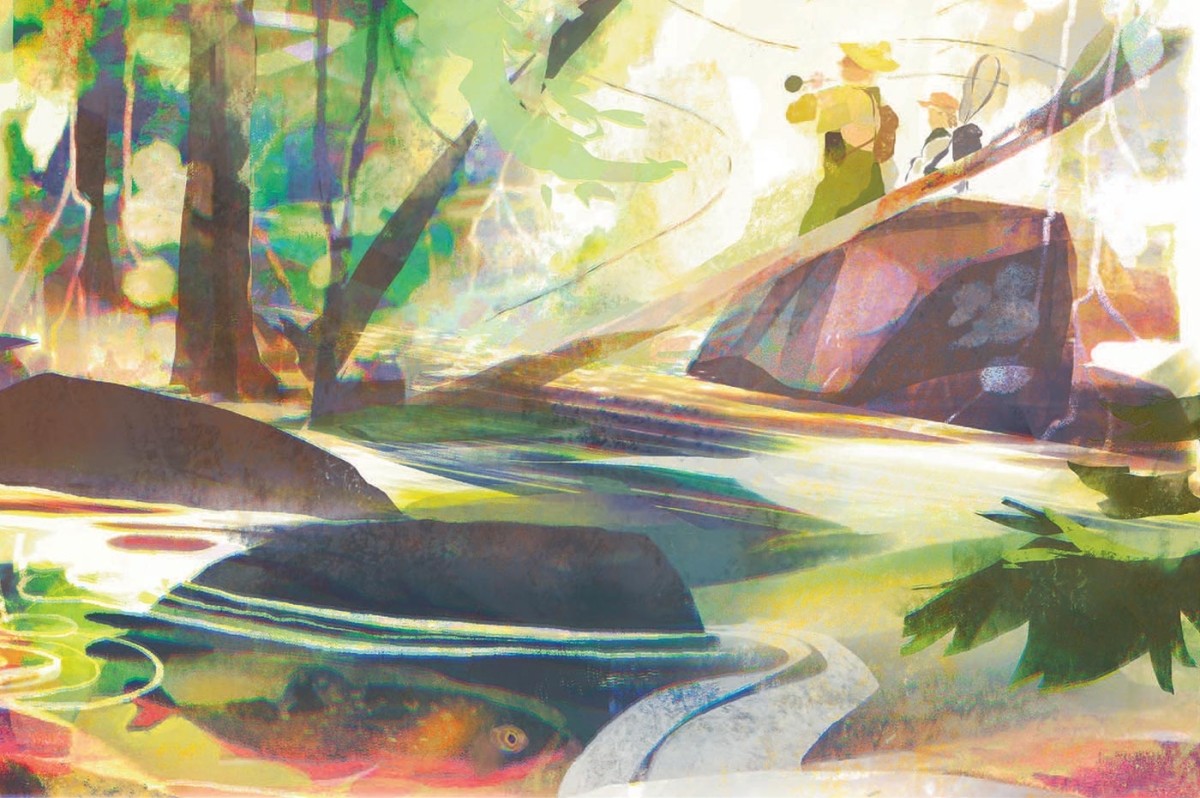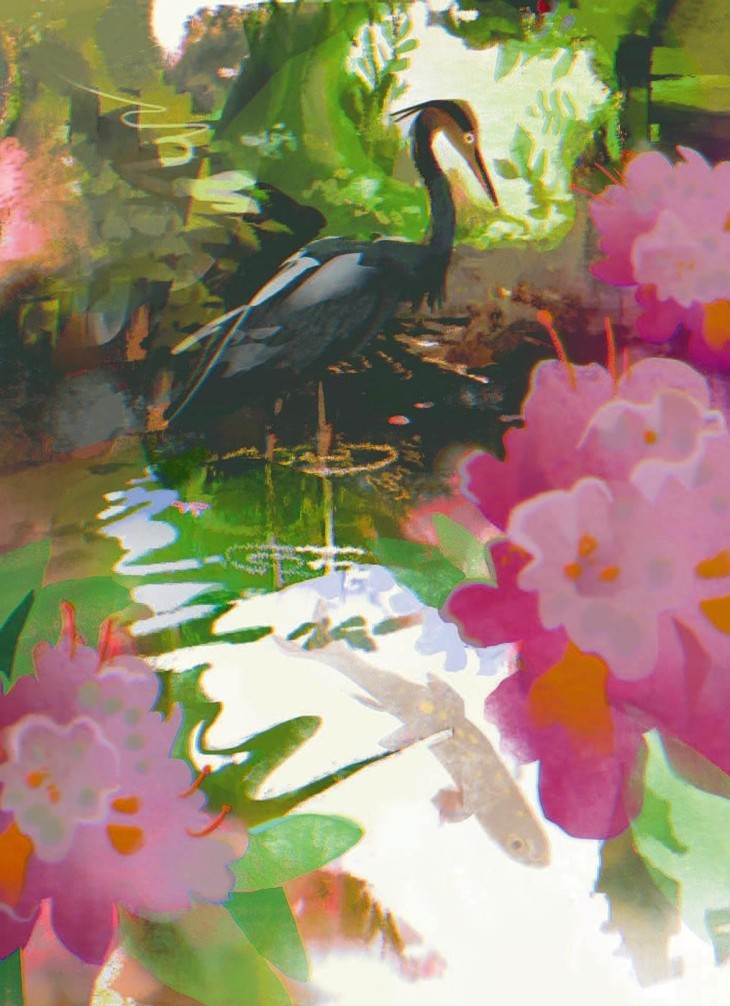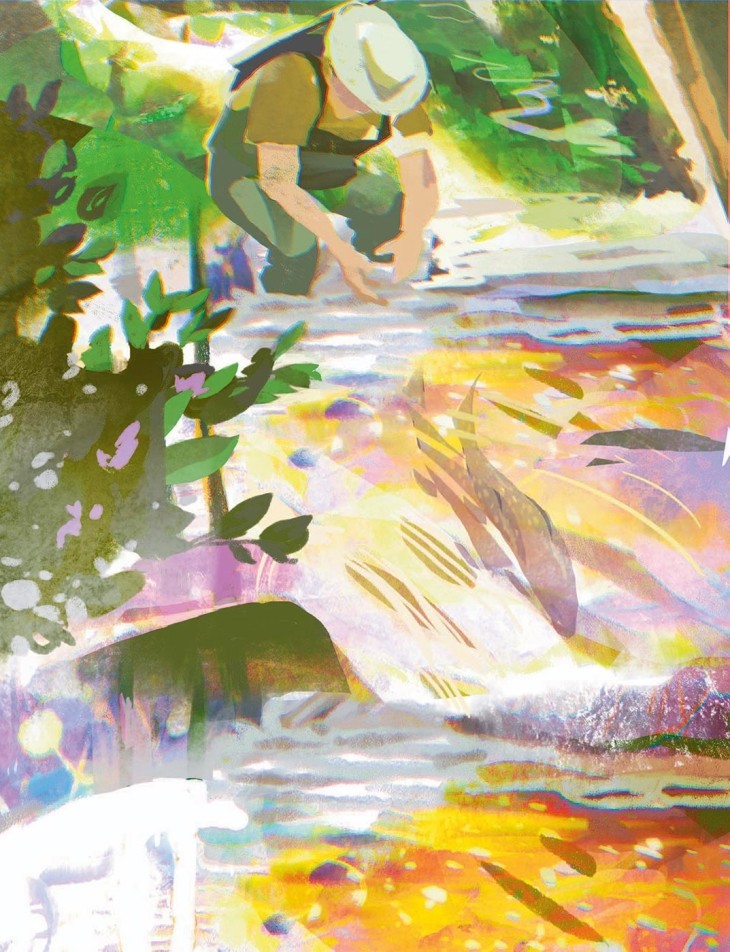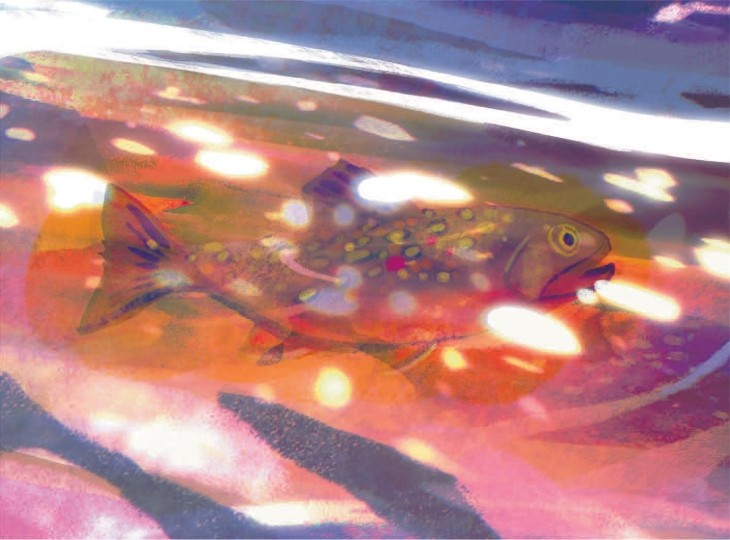
Noah moves ahead of me in the streambed, walking through a green tunnel, the rest of the world walled off. In July, the woods are thick with leaves, and the rhododendron that crave water grow in dense screens along the creeks that carve the hollows of the Allegheny Front. Here, old water has descended over hundreds of thousands of years, the passage of time marked by what erodes, geological presence trickling into humid absence.
We haven’t fished for some time. Low summer flows and work to be done in the garden. But a storm rumbled through last night, lightning flickering against dark windows like a child playing with a flashlight beneath a bedsheet. This morning, the air cleared, and temperatures plummeted nearly 20 degrees. Today, the stream looks like the month of May. It’s good to feel the cold water swirling around our legs, to lean against the current and imagine a pocket beneath the surface where a fish waits, watching for the drift of a caddis, ready to charge and engulf temptation.
Water claps stone, obscuring the splash of our steps. Ahead of us a great blue heron wades. The rhododendron boughs hide us from her as we cling to the tunnel’s edges. We watch her stillness, admire her predatory patience. Perhaps she’s aware of us, willing to allow us to come in to her presence. More likely she’s simply unwilling to let us ruin the fishing. We’re here for the same reason.
I want the trout to divulge themselves, to tell me something of their lives, something of the stream and how it undulates beneath the surface of things. Most of the time they’re hidden, eating what emerges from beneath stone. Unless they’re coaxed to the surface, they’ll sidle beside a rock, stay where the current storms overhead but is barely perceptible below, a pocket of safety and rest.
Today, with the water high but falling, brook trout grow bold, unafraid of the heron that stalks ahead of us, the kingfisher that click-clacks the air, the anglers casting hopeful lines. Some of that fearlessness is foolhardy. We’ve already seen one kingfisher with a fish draped across the half-open door of its beak. But some of that fearlessness makes sense. There’s more water to escape into, more depth for eye and talon to navigate.
Every time a fly touches the water, a take follows. Floats are short and the eruption from beneath the surface breathtaking, a gasp at the grace of a body emerging in an eyeblink, a slant or perpendicular thrust, then a curving back, a disappearance, making me ask if I’ve truly witnessed what I think I have.
It doesn’t matter how many times I spy a trout rise, I’m still awed. Enchanted and spellbound and, yes, addicted. Each rise leaves me unfulfilled, the concentric ripples moving away into a resolution of nothingness.
Most of the fish in these headwaters are 6 inches, a few reach 8 or 9. Beauty rests not in the size of the bodies but in their design: the glowing orange coals along male bellies, the purple coloration that engulfs female sides, the spectacle of olive vermiculation atop their backs. To hold a speckled trout is to grasp stained glass as it turns to muscle, a fluid prism that bends light and color with a strength that belies size.
Noah and I have already fished a few hours, covering more than a mile of stream in a seam that runs north to south, turning after a time to the east to join the big river in the valley. We still have miles to cover before this water turns too small and the fish vanish.
I’m not sure how much farther to go. There’s the question of whether more fishing might spoil the day, already gifted so many strikes. The strong tug that pulls the mind under water. The persistent reeling in, holding a glistening body, examining the scar on a side where the teeth of a larger fish or the claw of some ravenous bird raked months or years before. And while on some days we do eat these fish – delivering the quivering pink flesh to a darkened pan, butter melting across its surface and onto our tongues – today it feels good to open the hand to mercy, to see how mercy swims away to hide itself again.
More than half a century of walking makes me think we should head home, knees aching a bit. But I look to the sky, through the kaleidoscopic canopy and on to the everlasting blue. Shafts of sunlight descend haphazardly. I simply can’t waste an hour of this perfect day.
We head upstream toward the boulder pool where the water makes a moderate turn and the land slides against an enormous rock that’s broad as a shack. The eddy created on the left, downward side is deep and expands to the edge of the current that rushes from above. Trout can hold along the quickening water here and still experience a degree of tranquility. An ancient hemlock provides shade. This deep in the hollow, the ridges rise directly from the streambed at a precipitous incline.
We use all kinds of words to describe momentous events: 100-year-flood, storm-of-the-century, fish-of-a-lifetime. The challenge is how to simply be present, to accept the moment for what it reveals. Not to let the mind hurry ahead to the stories that will be told, to the implication that what has passed will likely never happen again.
And so, when the brook trout assails the fly I’ve drifted, rising vertically from the bottom of the pool, turning on it and driving down in the exact same direction it has come, I’m not prepared for the next few minutes and how they will change the way I see this stream, the way I perceive the life of a fish and its connection to mine.
My rod bends toward the point of breaking. The line runs fast, then stops. I pull back. The line creeps forward. Inches incrementally toward the boulder. Then nothing. A heaviness. No movement at all. Yet I can’t retrieve the line.
I shout to Noah that I think the trout’s wrapped me around a sunken log. A ponderous anxiety fixes to the ribcage, a feeling anglers know too well when they’re sure a special fish has eluded them, breaking the line, tangling them, and spitting a fly. I move forward into the pool, water rising around me. I bring the rod tip toward me and grasp the line to tug a bit harder, hoping to release the snag without breaking off the fly.
The slightest vibration works against my fingers. Can I hope the fish is still on? No, it’s simply the current. Then another vibration, clearly a shake. I bring the rod handle back to my grip, pull a bit, and the fish is swimming again, out from under that ancient boulder, swimming toward me fast and down past, then back by. All while I seek to maintain some tension.
Noah grabs the net from my back as I try my best to guide the fish toward him. The two of us together land a brook trout fully 15 inches in length. A female with a slick purple luster, a jaw gray with age, teeth that have devoured fry and fingerlings. She’s so much bigger than any fish we imagined could swim in this small water.
When we find ourselves in a joyous place, we humans tend to want to stop time, to arrest its passage. We know it’s not possible, so we take photos, perhaps record the event in a diary or journal. Some hunters and anglers turn to taxidermy.
I’ve never had anything I’ve hunted or caught frozen in that ancient art. But as I hold this fish, smiling at Noah, both of us shaking our heads and laughing at the beauty of this anomaly, the luck of such a blessing, I immediately think about having it mounted, a version of life sculpted to carry with me through the coming days.
The temptation is brief. Her life is the stream. I have no right to take it. She deserves another spawn, a last bit of summer before the blazing desire of autumn.
In opening my hands from around the belly of this ancient fish, in feeling her tail kick against my palms and watching her swim away, down and under the immensity of that boulder, I’m granted a vision. Is it simply my imagination or does this elder, in her last touch, imprint upon me some of what she’s seen?
All I know is that I find myself unexpectedly underwater. My ears fuzzy. Sounds of the forest far away. Noah’s voice an indistinct hum. And out before me, the submerged logs that stretch another quarter-mile up the stream. And above the logjam, the long pool beneath hemlocks whose boughs dip into the water if the flow is high enough, as it is today.
And the gravel where last year the redd was prepared in that ritual of love and longing for life to exist beyond our deaths. Where this female pushed her eggs. Where the milt settled. Where this past spring fry hatched, and all the fingerlings from the previous year darted, some to be engulfed by the mouths of larger fish.
The past washes over me, through me, with its ice and snow, with its floods, with drought and logging, moving back toward a glacial time, an ice shield whose force pushed up everything in its path, and those first char, from whom this ancient motherfish is descended, their memory deposited in her flesh, and now passed, even if incompletely, to me, simply because I’ve been granted the chance to hold her.
It is a glimpse of a possible future, too. A day in late October when I’ll walk the bank looking for her, seeing her start the path of another generation with a swish of her tail. Giving thanks for her and what she taught me, helping me to fall even more deeply in love with her beauty, with the necessity of her existence, with this water of life.





Discussion *